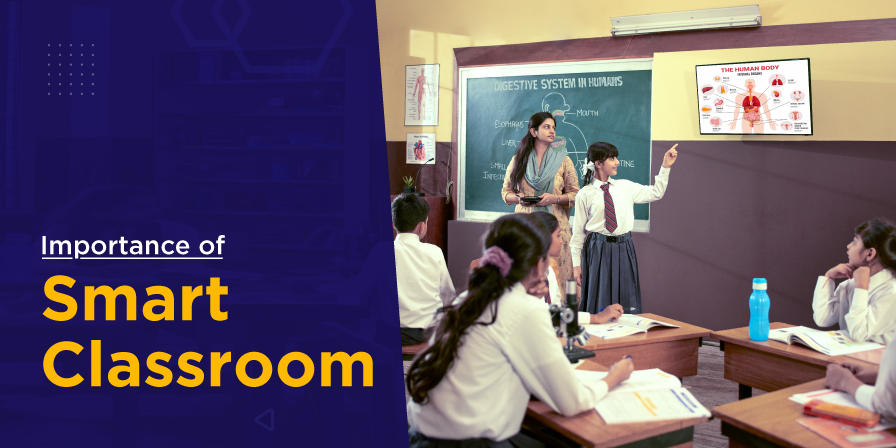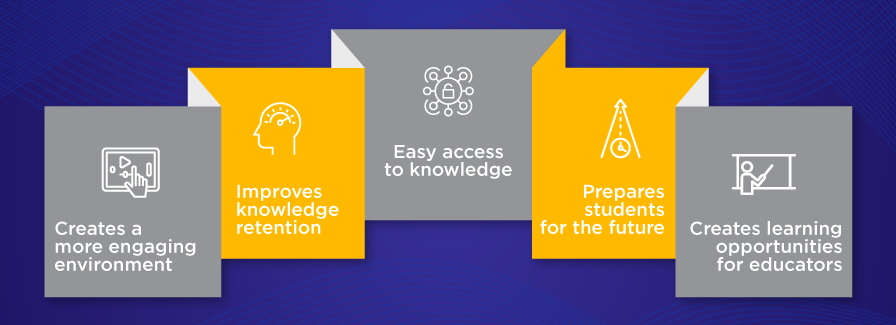The Importance and Advantages of Smart Classrooms in Education

The Importance and Advantages of Smart Classrooms in Education
Last Updated On: 12/02/2025
Siddharth Saxena
School Owner

“Teachers need to integrate technology seamlessly into the curriculum instead of viewing it as an add-on, an afterthought, or an event.” – Heidi-Hayes Jacobs.
In this article

What Makes a Classroom ‘Smart’?

5 Key Benefits of Smart Classroom

How Smart Classrooms Enhance Student Engagement

LEAD - Transforming Education with Smart Classrooms
What Makes a Classroom ‘Smart’? Uses & Key Features
Smart classrooms are equipped with the most modern educational technology, including visualisers, interactive whiteboards, amplifiers, speakers, podiums, microphones, and more. With the advent of such smart classrooms, learning is now enjoyable for kids, and teaching is less of a strain for teachers.
Never miss a story
Stay updated with the latest news and articles related to school education
GIVE YOUR SCHOOL THE LEAD ADVANTAGE
Top 5 Benefits of Smart Classroom for Students & Teachers
- Creates a more engaging environment
Students are sure to become interested when technology is incorporated into regular lessons. It makes education fun and enjoyable. For example, a teacher can use an engaging video to explain photosynthesis with the aid of smart classroom technology.
This approach promotes greater student involvement because smart classrooms can make challenging or uninteresting subjects more engaging.
- Improves knowledge retention
Technology-integrated classrooms fascinate students and build their interest in studies. With the aid of improved learning techniques, they are intrigued by the subjects and comprehend them better. Individuals can retain the information for a longer period of time when they grasp it better.
- Easy access to knowledge
A digital whiteboard and projector are typically included in a smart classroom. The Internet is a wealth of knowledge when it comes to the subjects taught in school. Students using the digital learning approach can access knowledge beyond the set syllabus under their teachers’ guidance. In fact, teachers can further facilitate the students with extra study material to enhance what they learn in class.
- Prepares students for the future
Students can become future-ready thanks to smart classrooms. Digital learning strategies place a strong emphasis on methods that are productive & collaborative and draw students’ attention to an interactive learning methodology.
Creating presentations, learning to distinguish between trustworthy and dubious sources on the Internet, adhering to proper online etiquette, and many other practical skills can all be developed with its aid. Early exposure to the development of these skills can help children get ready for future digital demands.
- Creates learning opportunities for educators
Even teachers can benefit from the aid of technology, as they can learn and improve their teaching techniques. The use of virtual classes, online tests, and grading tools helps teachers be more accurate and save a lot of time. This additional time can be used with students who need it or by the teacher to advance their own skills.
In the end, the abilities acquired while learning in a digitally enabled setting help to create stronger skills for tomorrow that the students will need in a college, university, or workplace.
How the Uses of Smart Classroom Improve Student Engagement
Interactive Learning Tools
Smart classrooms are equipped with interactive learning tools that make lessons more engaging and effective. These tools include:
- Use of Multimedia Content: Videos, animations, and simulations can bring subjects to life, making complex concepts easier to understand. For instance, an animation showing the process of photosynthesis can visually demonstrate the steps involved, helping students grasp the topic more effectively.
- Interactive Whiteboards and Touchscreens: These devices allow teachers to present information dynamically. Students can interact with the content directly, whether by solving problems on the board, manipulating digital objects, or engaging in interactive quizzes. This hands-on approach keeps students attentive and involved in the lesson.
Collaborative Learning Environments
Smart classrooms foster collaborative learning environments where students can work together and learn from one another:
- Group Projects and Peer Collaboration Tools: Digital platforms and tools facilitate group projects, allowing students to collaborate in real-time. Tools like shared documents, digital brainstorming boards, and project management apps help students coordinate tasks, share ideas, and produce collective work.
- Virtual Classrooms and Online Discussion Forums: These platforms extend learning beyond the physical classroom. Students can participate in virtual classrooms, where they interact with teachers and peers in real-time, regardless of location.
Online discussion forums provide a space for students to discuss topics, ask questions, and share resources, promoting a sense of community and collaborative learning.

“Equipping teachers with technology that will automate boring work will enhance education and make it more powerful. Teachers can spend more quality time on what they are good at i.e teaching.” – Unni Koroth.
LEAD Group - Enhancing Learning Outcomes with Smart Classrooms
LEAD Group is India’s largest school EdTech company that is revolutionising school education using the following ways:
- All LEAD Partner Schools are ‘smart’ because they provide real-time insights that enable teachers to actively help struggling students.
- The LEAD Group Student App is constantly updated with audio-visual lessons for multimodal learning.
- With LEAD Group’s smart classrooms, our commitment is to change the system from within. Strengthening the learning happening within the school structure will create lasting change and make students smart.
- All smart classrooms at LEAD Partner Schools are based on excellent pedagogical principles that have been thoroughly examined through the lens of an Indian student and her unique experiences. A great example would be English Language and General Awareness (ELGA) – LEAD’s pioneering approach to teaching English as a skill and not as a subject.
These are broad ways in which LEAD Group is changing the status quo in the Indian educational landscape and spearheading the transformation in education by leveraging smart classroom advantages.
Conclusion
LEAD does not look at ‘smart classrooms’ as a buzzword but provides a 360-degree offering to our partner schools — especially in Tier 2, 3, and 4 towns and cities in India and beyond. Get in touch with us today to learn more about how LEAD is bringing the ‘smart’ change in education.
Article Summary
- Smart classrooms are the need of the time and are changing the face of education.
- One of the smart classroom advantages is that teachers can use smart class tools to make the classroom interactive and learning more fun.
- As learning becomes more engaging with a smart classroom, students understand concepts better and retain them for longer.
- The same set of curriculum can be taught by teachers in so many methods with the aid of a smart classroom.
- Smart classroom advantages also include making students future-ready as technology permeates all sectors.


